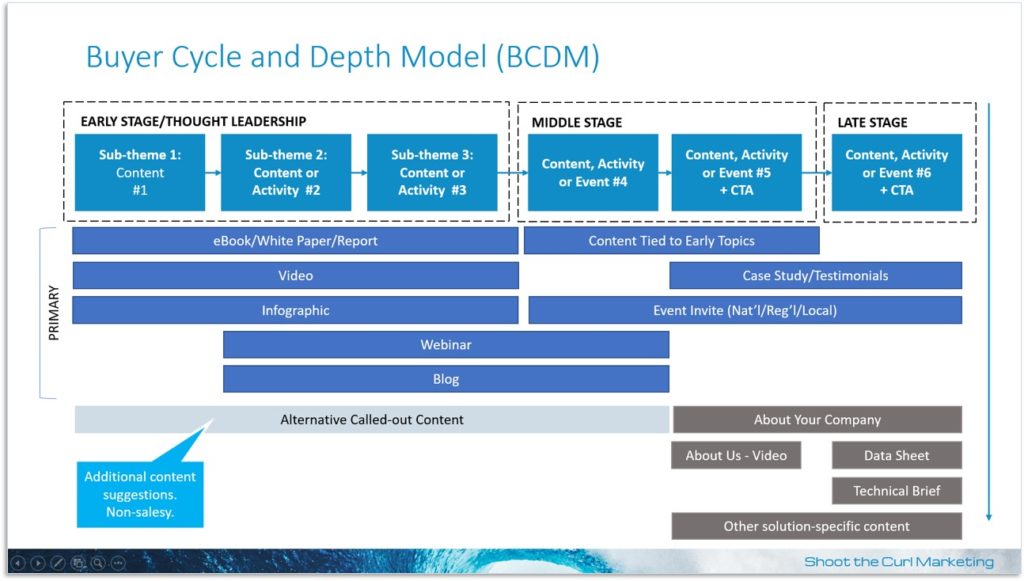The Buyer Cycle, Campaigns and Content Types
Product Marketing and Content Creation Go Hand in Hand – Important Things to Consider When Determining Content to Develop
Regardless of whether Product Marketing is tasked with the ideation and development of thought leadership and similar content or not, the fact is that Product Marketing must be thinking about it at all times and working to influence what is developed. I could argue that the role of Product Marketing is all about content creation – from data sheets to sales training decks to web copy, Product Marketing is always creating new content that helps to garner interest, deliver a message and ultimately, help Sales get as close to closing the deal as possible.
However, when thinking about content, it is critical to be thinking bigger picture. You shouldn’t go off and create a new white paper, eBook or video just because you think it would be great to have and it could plug a hole you feel exists, or could be used as a great asset to post on social media. You have to up-level the thinking.
ONE: START WITH A CAMPAIGN
First and foremost, you need to be thinking about a bigger, more impactful campaign-like approach you can take that will result in significant awareness and/or demand for your product, service or solution. And by the way, this campaign cannot be focused directly on your product, service or solution. The ‘theme’ (I know some marketers don’t seem to care for that word) needs to be some type of compelling interest-grabber, pain in the marketplace or other related topic that will make someone take a second to check out. This theme will be the air cover for eventually getting to talk about your offering.

You’ll notice in the graphic above that I call out sub-themes. Sub-themes represent related topics to the central theme but give you some flexibility in order to address a wider swath of people (as well as not create a fatigue with consumers of the campaign). For instance, if my overall theme was ‘Get to the Cloud, Securely,” my sub-themes might be ‘Overcoming the Cloud Migration Challenge,” “Illuminating Shadow IT and Risk in the Cloud,” “Avoiding the Pitfalls of Misconfigurations in the Cloud” or “Achieving Compliance in the Cloud” so that I am likely to raise the odds that some aspect of my overall “Get to the Cloud, Securely” campaign will resonate with my audience.
And you can’t forget about your personas or who you are trying to go after. I’ll talk more about the importance of personas (as well as their limitations) in another post. But you want to be very deliberate in who you are targeting with each campaign as you only have so many bullets in your gun to use to drive interest in and get your message across to potential prospects.
TWO: HOW TO PICK THE RIGHT THEME
In regard to coming up with the right theme, you need to give this some serious thought. This is where market and competitive insights should give the Product Marketer or Product Marketing team a strong sense of what needs to be talked about by the company in the marketplace. From experience, I’ve generated ideas for campaigns based on win/loss analysis that essentially told us why prospective companies came to our organization for help, through trending on our website and overall because I had a strong pulse on the market and the changing ‘conversations’ taking place. A great tip here is to get with your Demand Generation counterpart on what might be trending well for the company and come up with ideas together. Another great tip is to make sure that these people are trusted delegates in Marketing. In other words, be sure that their opinions within their respective areas of Marketing are well regarded and likely to be taken as the path to pursue by their respective leaders.
Once you have that theme selected, you need to work your way downward.
THREE: THE BUYER CYCLE AND DEPTH MODEL (BCDM)

The Buyer Cycle and Depth Model (BCDM) is a name I came up with but you can call it what you want. The distinction is that besides thinking about the types of content you need from left to right of the buyer cycle, you also need to think about the content that goes from high-level or topical to in-depth and specific to your actual offering that the campaign is supporting indirectly.
If you manage to pique interest, say on Content or Activity #3 and the reader wants to click for more information to the point that they want information on an offering up to and including a data sheet, you need to provide the pathway for that to happen. To borrow from a great Product Marketer I know, you need “on-ramps” to other content as the campaign progresses. In fact, you should never have a dead-end whereby someone gets a communication, sees a post, attends an activity and then there is no call-to-action or enticement into something else.
FOUR: GETTING TO CONTENT TOPICS
Congratulations, you’re halfway there. The next step after you have your campaign theme and sub-themes selected is to come up with compelling topics through all stages you believe would pique interest. Engage your Demand Generation counterpart here as he or she may have some fantastic ideas to share, and overall collaboration is what the campaign will need to come to fruition. Try the two of you and anyone else who should be involved to have each of you come up with a list of suggested topics and then discuss and agree on which are the most compelling.
As part of this process, it’s critically important to consider your current inventory of assets and what already exists that can be leveraged. And you should leverage existing content. But also be prepared to create new content as it’s likely your existing inventory is not enough to use in a new campaign. Note – If an existing asset isn’t that great but is generally focused on the theme or sub-theme at hand, I recommend not using it and creating a new asset. Your campaign is your best forward projection of the company. Why risk creating a poor perception because you didn’t want to take the time to create a compelling content piece.
Once you and your counterparts identify the content pieces you want to create and leverage for the campaign, you then want to consider the forms that content takes. If all you are doing is providing a string of text-filled pdf’s through the whole campaign, you’ve blown it. You want to consider videos (animated and talking head), infographics, blog posts, engaging web page concepts, webinars, etc. and pepper those in. Think about what format your personas like to consume content as a guide.
FIVE: RATIONALIZING CONTENT GOALS
At this point, I could guess that you actually have a larger list of content pieces to create than is achievable in the timeframe you have to get ready for the campaign. If this is the case, get back with your team and make some hard choices to bring this into line. If having overly aggressive goals on creating new content for a campaign means that the campaign itself is at risk of never happening, it’s better to get something out the door than nothing.
SIX: MAPPING TO A CALENDAR
Now, map everything to a calendar. What’s your desired campaign start date? Mark that and work everything backwards to see if it is achievable. I suggest a calendar in PowerPoint with months left to right and eveything captured like a roadmap.
SEVEN: GETTING LEADERSHIP BUY-IN AND BUDGET
The last stage is reviewing the campaign plan with leadership and ensuring your head of Marketing and other leaders in Marketing are on-board. They may ask you to sharpen the saw on your plans which is fine. They may throw in an idea on content which you may have to incorporate or change. That’s fine too. As long as you get their buy-in, and the budget needed, you’re off to the races.
There are, of course, more stages in terms of execution but we won’t discuss them here in this post. The hard part of strategy has been done here.
As a Product Marketer, David has successfully launched products, services, solutions and platforms across a number of disciplines in the technology industry. David’s passion for Product Marketing and his eye for seeing how Product Marketing can lead to even stronger business outcomes led him to bring his expertise and knowledge to Shoot the Curl Marketing.



